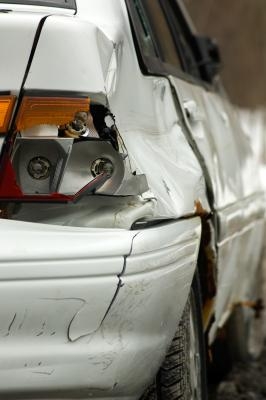
Automobiles can be damaged in the form of dings and small dents. Dents and dings can happen in parking lots and curbside parking, and hailstorms can result in multiple dents all over the vehicle's surface. Dents and dings can happen anytime and anywhere. The difference between a ding and a dent depends on the severity of the damage to the area. Dings are small repair items, as opposed to dents, which deform the metal more severely and need more involved repair techniques to remove them.
The width of a ding can be defined as an area of damage that measures about the size of a quarter, or about 1 inch across. They usually appear smooth, having not stretched the metal or broken the paint. A dent has a larger surface area, generally around silver dollar-sized to hand-sized, ranging from 2 to 5 inches across. A larger dent can measure more than 1-foot across, and have metal-stretch and paint cracking damage.
Dings appear relatively shallow in relation to the metal surface of the vehicle. The concave indentation ranges from microscopic to 1/4-inch in depth. The profile of the ding can be round or oblong. Dents can be shallow, where a panel has been pushed in over a large surface area, or they can be quite deep from a stiff pressure blow. The inward metal crease can be quite deep if the dent has been struck by a sharp object.
Dings often have very little stretch or deformity in the metal around their edges, because of their smaller nature and lower impact pressure. The shallow depth of a ding often keeps it from exerting flex on the surface paint. A dent that has resulted from an object impact can have severe metal fatigue and stretch, usually due to the hard or sharp surface of the striking object. Dents with gouges, creases, cuts or punctures changes the molecular structure of the metal by weakening it.
Dings are sometimes repaired with suction cups that pull the metal surface back into its original profile. Sometimes body hammers and dollies are used to tap the metal back into shape. Deep dents can require drilling and hook tools to pull them from the outside. Paintless dent repair tools -- such as the soft tip rod or knuckle rod -- have interchangeable tips called tumblers and drivers. The knuckle rod, used on dings, can reach behind a narrow panel and massage the ding outward. Body hammers and dollies can also be used on larger dents.
Dings can result from sudden door openings against solid objects, usually with soft to medium impact forces. Hail causes dings of various sizes, depending upon the weight and diameter of the hail stones. Hail stone dings are usually uniform in size and depth, but can effect entire roof, trunk or hood panel. Dents result from harsher impacts, like vehicles or other heavy objects.